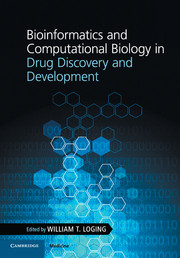Book contents
- Frontmatter
- Contents
- List of contributors
- Foreword: The future of drug discovery and healthcare
- Acknowledgments
- 1 The art and science of the drug discovery pipeline
- 2 Computational approaches to drug target identification
- 3 Understanding human disease knowledge through text mining
- 4 Integrating translational biomarkers into drug development
- 5 Computational phenotypic assessment of small molecules in drug discovery
- 6 Data visualization and the DDP process
- 7 Information visualization – important IT considerations
- 8 Example of computational biology at the new drug application (NDA) and regulatory approval stages
- 9 Clinical trial failures and drug repositioning
- Appendix I Additional knowledge-based analysis approaches
- Appendix II Open source tools and public data sources
- Index
- Plate section
- References
2 - Computational approaches to drug target identification
Published online by Cambridge University Press: 05 February 2016
- Frontmatter
- Contents
- List of contributors
- Foreword: The future of drug discovery and healthcare
- Acknowledgments
- 1 The art and science of the drug discovery pipeline
- 2 Computational approaches to drug target identification
- 3 Understanding human disease knowledge through text mining
- 4 Integrating translational biomarkers into drug development
- 5 Computational phenotypic assessment of small molecules in drug discovery
- 6 Data visualization and the DDP process
- 7 Information visualization – important IT considerations
- 8 Example of computational biology at the new drug application (NDA) and regulatory approval stages
- 9 Clinical trial failures and drug repositioning
- Appendix I Additional knowledge-based analysis approaches
- Appendix II Open source tools and public data sources
- Index
- Plate section
- References
Summary
Introduction/overview
In this overview we will examine drug target identification, a key early step in the drug discovery and development process and a significant and interesting challenge. Today, target identification is akin to solving a very difficult puzzle using all of the information that we can generate or have available to identify those points of intervention within a highly interconnected dynamic system that will improve a disease state. I see our current approaches as surrogates for a true understanding of the molecular basis of disease, which when achieved should clearly reveal points for therapeutic intervention. Before we attempt to discuss methods used for target identification, we will begin by exploring what a target is and what hurdles a potential target must overcome to be successfully “drugged.” We will examine how the targets from currently approved drugs have been elucidated. A brief historical perspective on target identification will focus on how advances in our understanding of biology have driven our progress. Finally, we will review current directions in selecting drug targets and in understanding disease in an integrated and multi-scale manner.
Drug development is a long and intricate process but one that is quite predictable. The development of a drug usually begins with the selection of a molecular target for modulation by a small molecule or biological compound with the goal of safely improving a disease phenotype. The target concept can be logically extended to include plant biology and perhaps synthetic biology. Crop improvement by increasing yield, quality (i.e., amino acid composition), and insect or drought resistance require identification of points for molecular intervention to bring about the desired phenotype. Similarly, synthetic biology projects require the manipulation of existing biological systems or ultimately creation of modified biological systems, and require a very high level understanding of the genetic and molecular processes involved in producing the desired outcome without destabilizing the system. Our review here will focus on target identification for the purpose of drug discovery and development to address unmet medical need.
Drug discovery research is performed at many levels: in the pharmaceutical industry, in biotechnology companies, government laboratories, research foundations, increasingly in computation-based companies, and even larger generic drug companies. In terms of dollars and number of drugs approved, the pharmaceutical industry has been the largest sector in drug discovery to date.
- Type
- Chapter
- Information
- Publisher: Cambridge University PressPrint publication year: 2016



